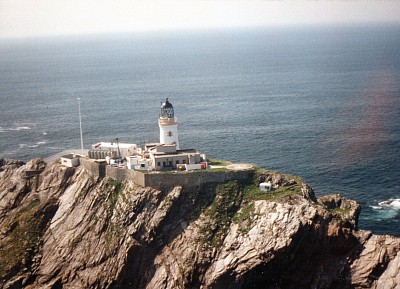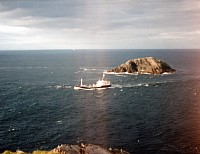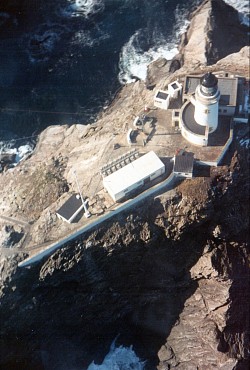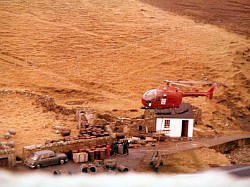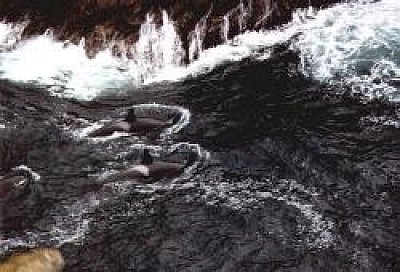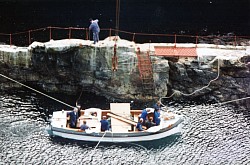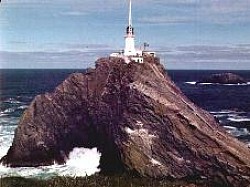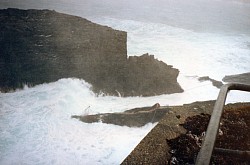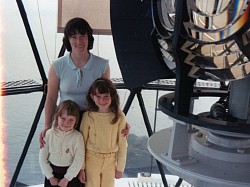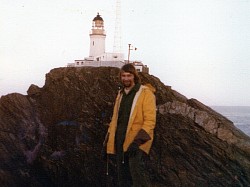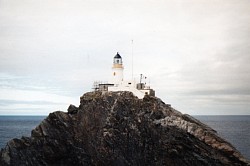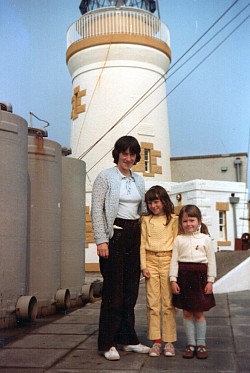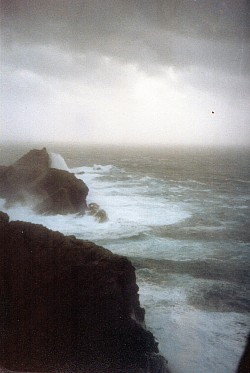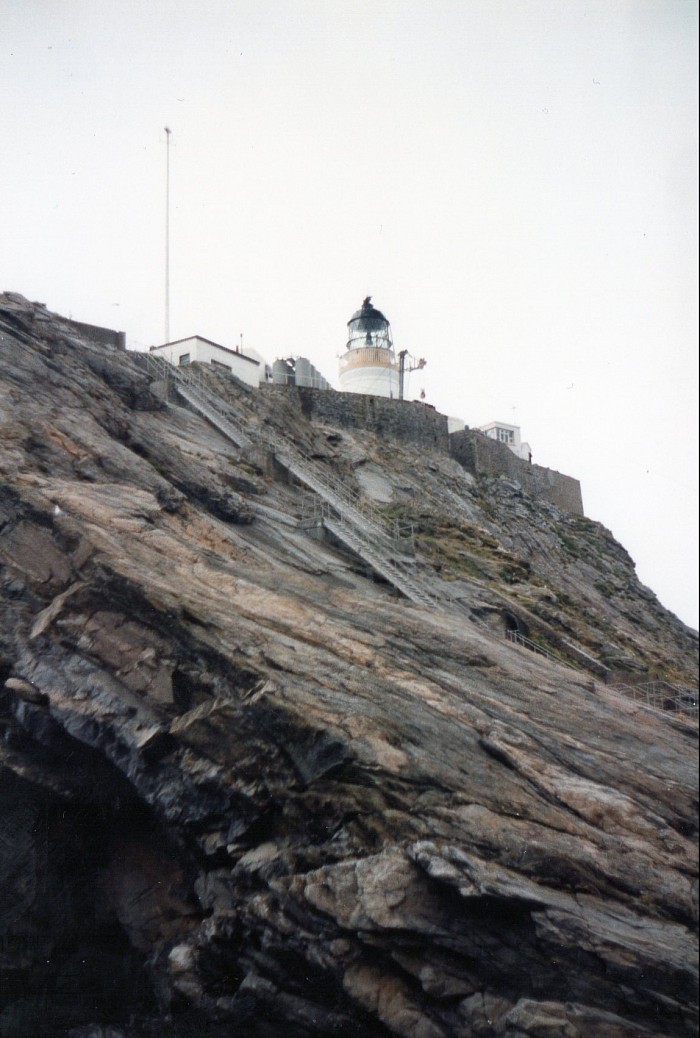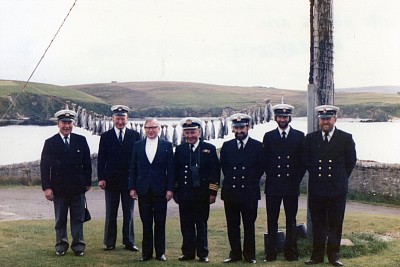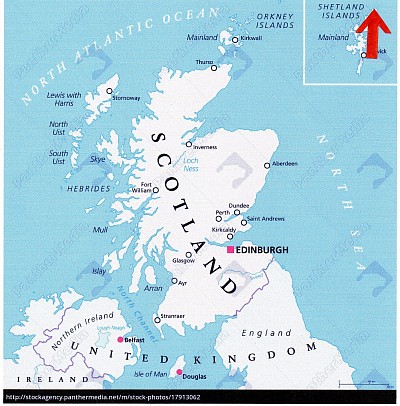Muckle Flugga, Shetland islands
Muckle Flugga, Since the early eighties access to the Muckle Flugga has been by helicopter, the keepers being uplifted at the shore station in Burrafirth, a good 3 minutes flight time away wow! When approaching the lighthouse from the air for the first time it is an impressive and intimidating sight, more so at the thought of having to stay there for a months duty, but as most situations in life it rarely turns out as bad as first impressions would have you think. The surface of the rock that is flat is only about twenty- five mtrs. by sixten mtrs. if my memory serves me right, so there isn’t much in the way of exploration potential. The light has seen a few changes over the years, a new accommodation block has been added and a separate engine room squeezed on top of the rock a few mtrs from the original one, the light only stands eighteen mtrs tall but standing eigthty meters above sea level. The illumination is provided by one 3500watt electric bulb which is really only a larger version of your domestic bulb. but more than likely the light will be of the LED type by now, The weather there could be of two extremes, in the winter the gales could be horendous, and although the light sits eighty mtrs up, lumps of sea water would regularly crash onto the lantern panes, if you were in the lantern room at the time; you were glad the panes were thick and had a small surface area to with stand the beatings they got. The gales were usually worst through the night( or so it seemed ) for you would go out to the courtyard in the morning to find stones and weed from the sea bed strewn about. There are tales from the old keepers that when stepping outside they would be created by the sight of fish lying in the courtyard (fishy tale ?!), a lot stranger things have happened, the reason the sea was able to attain such heights is that on the westerly side of the rock it hollows out to give a large indent so when you had the westerly gales the waves and swell would hit this indent, be directed back out and collide with the waves coming in again causing the two to go skywards. On one new years’ night the two keepers and a supernumerary keeper (trainee) were out in to the temporary radio room exchanging hogmanay cheer with other lighthouses. The radio room at that time was situated in a corner store across the courtyard. As is normal the lighthouse station would try to contact each other to exchange new years cheer. The Supernumerary ran across to the accommodation block to bring back some new years toast but he seemed to be taking rather a long time. When he did return and opened the door, one dreiket light keeper with water running out of everywhere greeted them – the keepers had forgotten to tell him the cardinal rule – that you have to time the waves breaking over the courtyard! However it hadn’t dampened his spirits and a good night was had by all.
The winter nights were more than often pretty wild but you would get the occasional times when the skies were clear and the air was still, and around midnight to 2am the aurora borealis would put a show on for us. The displays varied from an all over glow or dancing lights or even search lights panning the night sky, invariably they would be white but we could also be entertained by colored displays. These quiet still evenings would help to balance out the harsher times that nature threw at us. We regularly saw the fishing boats passing by us, and often it would be a case of now you see them, now you don’t as they would disappear down the trough in the swell, watching them would make you glad that you were on terra firma, albeit a small piece.
The summers were a better proposition hardly what you would call mediteranean but the days were clear and warm, with the sun rising brightly in the east bringing life to the flowers and birds. The rock was home to quite a variety of birds, my favourite being the wee puffins (tammie norries) with their black overcoats and colourful striped bills. They had their burrows covering the south-east face for light and warmth.They were very comical creatures and cute, but they had a hard life mainly due to the great skua (bonxie).These aggressive birds were the size of a very large seagull and would circle round and wait for a puffin to peek out from its burrow and then proceed to dive bomb the hapless birds. This behaviour used to annoy the keepers so if we were standing at the railings at the time we would throw stones to frighten the bonxies away but we all knew inwardly this was a futile exercise though at least it did make us feel we were trying to help. On some of these fine days we would sit in the courtyard and splice the ropes used for tying up the relief boat and often while sitting there you would hear, in the stillness, the tourists laughing and talking, as they walked on the slopes of Hermaness, only a few miles away across the sound, We would lift the binoculars to look through only to find them looking back at you through their binoculars. A pleasant interlude to daily routine was when the round Britain race was being held and we would watch the yachts rounding the Flugga as they competed sporting their colourful spinnakers as they ballooned in the light breezes. We would occasionally receive a call from the coastguard to keep a look out for a particular entrant and report their position and state so we’d be jotting down numbers, names and colours to make sure of a positive identification.
The photo opposite shows a family of killer whales that used to visit us regularly every year (I wonder why all the seals did disappear at that time.) The Flugga used to be host to a large colony of grey seals but due to a certain episode which I do not wish to go in to concerning some shotscrete contracting workmen, they all vanished during the mid 80’s, even in the seal world tragic news travels fast, fortunately they did start to repopulate over several years. One adverse point of the summer weather was the occasional fog and during these times we would find birds in the courtyard that were stranded after hitting the light, thankfully there were only a few fatalities. One small bird that we used to find was a Storm Petrel, an attractive wee thing with its jet- black velvety appearance. We reckoned that its nest was just over the wall on the cliff on the west side as on still nights you could just make out what sounded like their chirp. On these foggy nights the frightened bird would scurry across the courtyard with its wings out but drooped and go into a corner. At first we thought it had a broken wing and captured it to try and give it some first aid but it was alright. It must have just been the characteristic display it would use in that situation, so from then on we would just leave it to itself.
The keepers wernt without a sence of humour on one ocassion when the supply boat ( the Grace Darling) was bringing out the barrels of fresh water the keepers had managed to make up what looked like a lightkeeper from a distance they dressed it up and had it standing leaning on the rails at the top of the rock, the unloading of the barrels carried on being hooked onto the blondin wire and winched up to the top of the rock this went on for awhile untill the boats crew piped and wanted to know who was that lazy ***** doing just standing there and lettting the others do all the work.
I was stationed at the flugga for six and a half years and in that time I experencienced a lot more than at any other station, from tankers almost running aground, michela strauchan visiting us,diving for a lost watch, radio interviews, being a met station, being stranded halfway down a cliff, and so on,its only when you look back, you realise that so much went on that you didnt appreciate at the time
Picture taken from the rumblings, you can just see the blondin wire that brought the fresh water and stores ashore, before the blondin there was a railway type track that ran down the rock face and a buggy was hauled up to the top
The family on the annual outing to the flugga the kids would be up to the top of the rock in no time leaving the adults far behind huffing and puffing climbing the zig zag aluminium stairs
